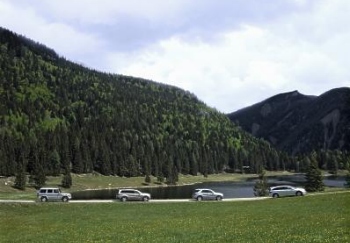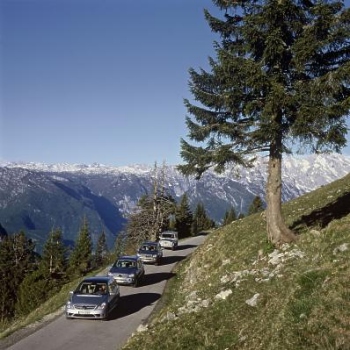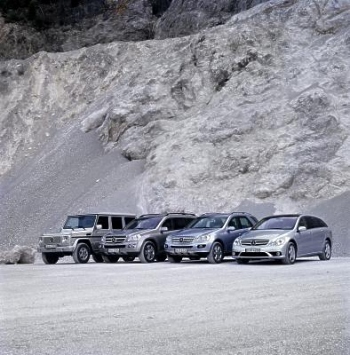
Automotive Intelligence - the web for automotive professionals and car enthusiasts
June 20, 2007
This Week:
-
50 Years Later the “Buried Car”, a 1957 Plymouth Belvedere, is unveiled in Tulsa, Oklahoma
-
MINI United 2007: MINI Fans will meet in Zandvoort near Amsterdam, NL, for a Three Day Festival
-
European premiere of the Audi Cross Coupé quattro study at The Design Annual in Frankfurt
-
Relearn to Drive: BMW’s Performance Driving School aims at safer driving
-
2007 DARPA Urban Challenge in the US: Volkswagen to enter sensor-driven Passat
-
DaimlerChrysler Truck Group enters Strategic Cooperation with Fiat Powertrain Technologies
-
American Honda Opens New Midwestern Consolidation Center in Troy, Ohio
-
GM To Invest $100 Million In New York Plant For Diesel Engine Production
-
Mercedes’ Dr. Rodolfo Schöneburg receives U.S. Government Award for Safety Engineering Excellence
© 1998 - 2007 Copyright
&
Disclaimer
Automotive Intelligence,
www.autointell.com
All Rights Reserved .
For questions please contact
editor@autointell.net
|
Mercedes-Benz celebrated big SUV show in Kitzbühl, Austria The most varied range of SUVs in the premium segment comes from Mercedes-Benz A close look at the model range in the R, M, GL and G-Class quickly shows that one of the 30 basic models available is bound to match up to the relevant individual requirements. With many detailed improvements, the R-Class is the model series with the widest range of variants and particularly excels with its outstanding long-distance comfort, as well as the most spacious and variable interior with up to seven seats.
The M-Class is the best-seller of all the Mercedes-Benz Sports Utility Vehicles, and is particularly popular by virtue of its well-balanced characteristics. This series celebrated its much reported debut ten years ago, and is seen as the precursor to all modern premium SUVs. The Mercedes-Benz GL-Class occupies the peak position in the entire SUV world, and its occupants enjoy first-class travel under any conditions, both on and off the road. |
|
|
|
The solid and dependable "G" best displays its strengths off the beaten track, and is acknowledged as one of the world’s best cross-country vehicles. Mercedes-Benz demonstrates the potential of the diesel engine with the innovative Vision BLUETEC models in the R, M- and GL-Class, where fuel economy and very low exhaust emissions are at the centre of ongoing development work. Even greater interior adaptability, two wheelbase lengths, rear-wheel drive or 4MATIC all-wheel drive, new engine variants and new, even more striking styling – the Mercedes-Benz R-Class now opens up even more possibilities. |
For the first time, the R‑Class features a second row of seats for three people, providing scope for completely new seating arrangements: this touring SUV now provides seating for five occupants, however two, three, four, six or seven seats are also possible. In addition the owner of an R-Class has the benefit of an unbeatably large and versatile load compartment: the short-wheelbase R‑Class can carry a maximum of 2001 litres, while the figure for the long-wheelbase version is a massive 2436 litres. This makes the R-Class the most variable and spacious model in the entire Mercedes-Benz passenger car range.
|
|
R-Class: choice of rear-wheel or 4MATIC four-wheel drive On the outside, the SUV Tourer is now distinguishable by an even more striking bodystyling package at the front and rear, as well as 18-inch light-alloy wheels, for all V6 versions. The top-of-the-range R 500 4MATIC is fitted with 19-inch wheels. The engine line-up is augmented by the new V6 petrol powerplant in the R 280, which shines with its impressive power delivery and moderate fuel consumption. Mercedes-Benz now offers three new entry-level R-Class models – the R 280 CDI, the R 280 and the R 350 – all of which are V6 versions with rear-wheel drive and a choice of a short or long wheelbase. |
Thanks to the reduction in weight and inherently lower friction losses in the powertrain, the rear-wheel drive models return even lower fuel-consumption figures. The most fuel-efficient R-Class is now the R 280 CDI which consumes just 8.9 litres of diesel per 100 km (NEDC combined). More power, lower fuel consumption: new V8-engine for the M-Class
|
|
The Mercedes-Benz M-Class has entered the new model year with a new engine. The 285 kW/388 hp model ML 500 4MATIC is now equipped with the 5.5-litre V8 petrol unit, which increases the output by 82 hp compared to the preceding model and boosts the maximum torque from 460 to 530 newton metres. This power increase has a considerable effect on performance: the ML 500 4MATIC now accelerates to 100 km/h in 5.8 seconds, and has a maximum speed of 250 km/h. This increase in power and performance is not matched by a higher fuel consumption, however, as the NEDC combined consumption has been reduced by 0.6 litres to 12,8 litres per 100 kilometres. The range of petrol models is complemented by the 200 kW/272 hp model ML 350 with a V6-engine, as well as the high-performance ML 63 AMG with 375 kW/510 hp. |
The top model in the diesel range is the ML 420 CDI 4MATIC, which develops an output of 225 kW/306 hp and a maximum torque of 700 Nm, and therefore has the highest torque of any model in the entire M-Class series. In addition to the V8 diesel there is a choice of two other diesel units, both of them offering excellent performance with an even lower fuel consumption. The basic V6-engine in the ML 280 CDI has an output of 140 kW / 190 hp, while the ML 320 CDI with the same displacement generates 165 kW/224 hp. Both versions consume just 9.4 litres of diesel per 100 kilometres.
The first generation of the M-Class (W 163) was launched in 1997 and is acknowledged as the precursor to all modern premium SUVs, with worldwide sales of around 600,000 units before its replacement in 2005. The present W 164-series M-Class is set to continue this success story, and 250,000 Mercedes-Benz customers have already purchased current model.
GL-Class: top model in the SUV sector
|
|
With the GL-Class, Mercedes-Benz occupies the peak position in the market segment for luxurious Sports Utility Vehicles. This premium off-roader excels with excellent driving dynamics both on and off the road, and spoils its occupants with outstanding spaciousness together with the comfort of a luxury-class saloon. With its confident and imposing external appearance, the GL-Class visually substantiates its claim to leadership in the hotly contested, worldwide market segment, while the interior welcomes its occupants with the typical Mercedes-Benz atmosphere of luxury and comfort reminiscent of the S-Class. The range of engines comprises four ultra-modern units whose harmonious torque and power characteristics decisively contribute to driving pleasure. |
The V8 diesel engine of the GL 420 CDI 4MATIC develops 225 kW/306 hp and 700 newton metres of torque for superior drive characteristics, while the well-proven V6 unit of the GL 320 CDI 4MATIC guarantees effortless progress with 165 kW/224 hp and 510 newton metres. Like all diesel models in the Mercedes-Benz passenger car range, these two common-rail diesels are equipped with a maintenance-free particulate filter. A second eight-cylinder model is available in addition to the 285 kW/388 hp, 5.5-litre V8-engine in the GL 500 4MATIC – the GL 450 4MATIC with a peak output of 250 kW/340 hp.
In combination with the innovative 4MATIC four-wheel drive system, AIRMATIC air suspension as standard, precise speed-sensitive power steering and the likewise standard Adaptive Damping System ADS, the majestic GL (wheelbase 3075mm) delights its occupants with impressive handling and excellent ride comfort. And while the GL already cuts a very good figure on the roads, it is a genuine off-roader which also excels as a cross-country vehicle. The modified AIRMATIC system allows a ground clearance of up to 307 millimetres, and the standard Offroad-Pro engineering package considerably enhances the capabilities on difficult terrain with its low-range transmission and disc-type locks at the rear and centre differentials. Other electronic control systems such as Offroad-ABS, Downhill Speed Regulation (DSR) and start-off assist help to reduce the driver’s workload even further.
G-Class – 28 years of development work for sheer perfection
Even in its 28th production year, Mercedes-Benz is rigorously continuing a model strategy for the legendary G-Class which is just as unique as the classic off-roader itself: the striking body shape and indestructible base structure have been retained since 1979, and at the same time constant evolutionary improvements still reaffirm the technical leadership of the "G". The latest model facelift mainly affects the interior, where a new instrument cluster provides a more up-to-date look. Together with a centrally located display for the driver, four analogue dial instruments with fine chrome bezels provide a clearly laid out information centre. The elegant, four-spoke multifunction steering wheel has also been redesigned, while the modified centre console improves operating safety and upgrades the cockpit in visual terms. The standard appointments in the G 500 and G 55 AMG petrol models include the control and display system COMAND APS with a DVD navigation system, integral radio, CD-player and telephone keypad. Bi-xenon headlamps and foglamps with cornering lights are likewise standard equipment in all versions. Externally the new model is only distinguishable by discreetly modified rear lights. The "G" continues to be available in three body variants: two station wagon versions with a short or long wheelbase, and an extravagant Convertible with an electro/hydraulically operated roof.
Now as before, the classic among Mercedes-Benz off-road vehicles offers a superior synthesis of effective drive and dynamic system. In addition to permanent four-wheel drive with a low-range, off-road gearbox, standard equipment includes the electronically controlled traction system 4ETS, the Electronic Stability Program ESP® and three differential locks which can be selected at the touch of a button. Magna Steyr in Graz, Austria, has been producing the G-Class on behalf of Mercedes-Benz since 1979, with around 190,000 produced to date. And no end to this success story is yet in sight.
The "G" will continue to complement the Mercedes-Benz model range of highly capable SUVs in the coming years. Confirmation of the eternal youth enjoyed
by the G-Class recently came from the well-known off-road magazine "4wheel fun": in a vote for the "2007 Superstar" in the luxury category, this classic vehicle was declared the winner by a wide margin.
BLUETEC - the future of the diesel engine
Impressive output, high torque, a low fuel consumption and very low exhaust emissions – the Vision BLUETEC models in the GL, M and R-Class demonstrate that this innovative drive technology is particularly able to develop its potential in large, high-performance SUVs. The promising future of the BLUETEC concept is well illustrated by the Vision GL 320 BLUETEC. This muscular SUV with a powerful V6 diesel engine has an output of 165 kW/224 hp and a torque of 510 newton metres, has an average fuel consumption of only 9.9 litres of diesel per 100 kilometres and meets the most stringent worldwide exhaust emission standards.
Mercedes-Benz has developed two versions of the modular BLUETEC emissions control system, both of them with the same purpose, namely to reduce nitrogen oxide emissions. This is the only diesel exhaust gas component whose levels are inherently above those of petrol engines. In the E 320 BLUETEC saloon already launched in the USA, an oxidising catalytic converter and a particulate filter are combined with an improved, particularly durable storage-type NOx catalytic converter and an additional SCR converter. The second BLUETEC version is even more effective, and can also be used in the Vision GL 320 BLUETEC,
Vision ML 320 BLUETEC and Vision R 320 BLUETEC shown here. In this case AdBlue, a harmless, aqueous urea solution, is sprayed into the exhaust tract, where the downstream SCR catalytic converter reduces up to 80 percent of the nitrogen oxides to harmless nitrogen and water.
All Photos: Mercedes-Benz
(June 15, 2007)
| .
Homepage News Companies Management Publications Events Guestbook Search . |



